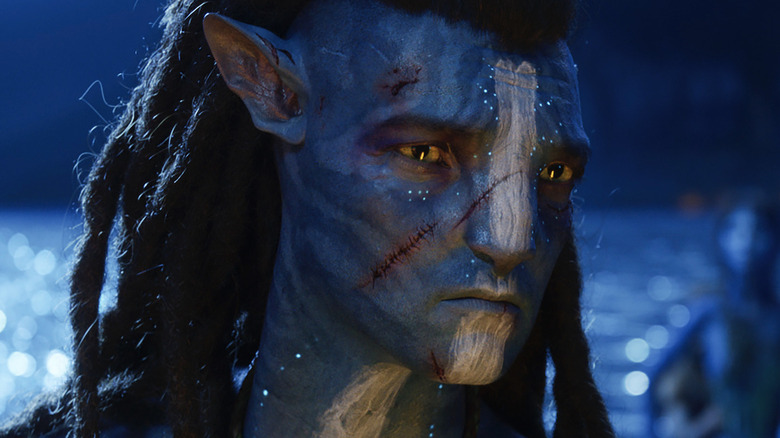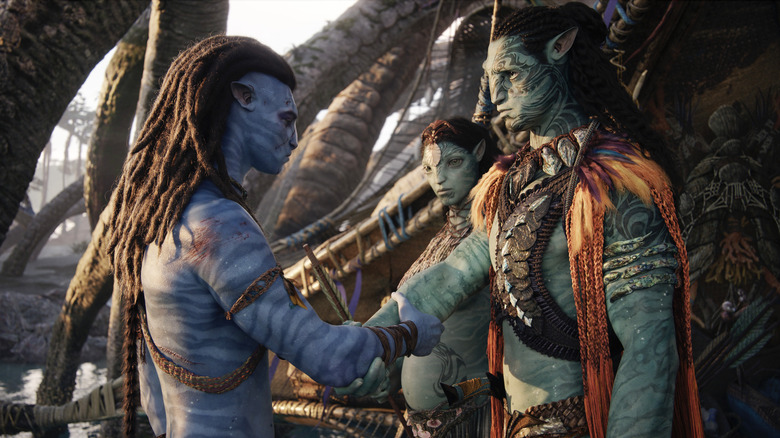Avatar Superfans Have Expanded The Na'vi Language In Mindblowing Ways
Stripped of its rich cast of characters and breathtaking sci-fi action sequences, "Avatar" plays out like an interplanetary nature doc, minus the requisite David Attenborough narration. In the eye-popping follow-up "Avatar: The Way of Water," Oscar-winning director James Cameron leans into the natural splendor of Pandora, where he explores the planet's aquatic microbiome — including the whales — to dazzling visual effect.
Of course, Cameron is just as interested in expressing the cultural diversity on Pandora. "In doing my research on indigenous culture," the director said in a conversation with Variety, "you just see such an explosion of ideas and wardrobe and belief systems." Perhaps none of Pandora's cultural exports have left as lasting an impact as the Na'vi language. First developed ahead of the 2009 blockbuster film, Na'vi is to "Avatar" what Klingon is to "Star Trek" — both a linguistic feat and a way for audiences to express their intense fandom.
Avatar fans have helped create hundreds of new Na'vi words
Dr. Paul Frommer, a professor and linguistics consultant, looked to Polynesian languages when he developed Na'vi in 2005 for the first "Avatar." "[James Cameron] wanted a complete language, with a totally consistent sound system, morphology, syntax," Frommer told NPR. Frommer then taught the language to the cast, loading up their iPods with sample recordings.
"At this point, I'm pretty much the only one who knows the grammar," Frommer said in 2009. "Maybe that'll change as time goes on. ... Who knows?" It certainly did, in ways Frommer clearly didn't expect. "Avatar" superfans have adopted the language as their own, and online communities like Learn Na'vi and Kelutral (the Na'vi word for Hometree) exist to link "Avatar" fans and study the Na'vi language. Per Rolling Stone, Learn Na'vi and Frommer have collaborated to expand the language from 500 words to about 2,600. Learn Na'vi also provides resources on grammar and phonetics.
For fans like Kelutral co-founder Seth Wright, Na'vi is a tool for building community internationally. "There are people around the world who don't speak English, but have learned Na'vi," Wright told Rolling Stone. "I have a common language with them and can communicate with them even though I may not speak their native tongue."
MIT researchers are studying the effects of Na'vi on fans' brains
Now, Na'vi is no longer just a niche fan obsession. MIT researchers Evelina Fedorenko and Saima Malik-Moraleda are studying the impact of Na'vi on neural language networks, along with Esperanto, Klingon, and Dothraki and High Valyrian from "Game of Thrones" (via Rolling Stone). After looking at dozens of natural languages, the pair pivoted to constructed tongues. They then scanned the brains of a number of Na'vi speakers, including Corey Scheideman, who has been teaching and learning the language for over ten years via Learn Na'vi. [In 2010], people were using movie lines that they heard or there was like a little dictionary out at the time," said Scheideman, "but it had like only 450 or so words."
The attention from academia may be validating, but for "Avatar" fans, the linguistic fruits of Learn Na'vi and Kelutral are their own rewards. To date, Kelutral hosts over 3,000 members on Discord, and the group serves as a haven for those feeling the "Avatar" blues.
"The people who actually like to devote themselves to learning an entire constructed language, as you can imagine, are a lot slimmer than the people who are just broadly interested in the language itself," said Kelutral co-founder Seth Wright. "If you cannot do it with the tools provided, then you have got to create your own, and that's how Kelutral came to existence."


